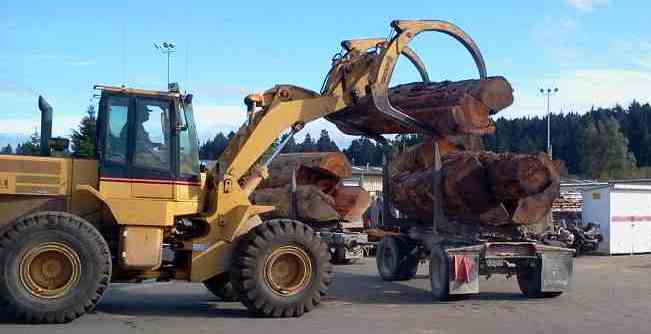
Responsibly Sourcing Salvaged or Reclaimed Redwood
Is all salvaged or reclaimed wood considered “green”? The answer is no. It can only be considered “green” if it is used within 250 miles of where it came from, otherwise, it’s just salvaged or reclaimed. Today we are going to talk about the definitions of some of these words, and how they apply to old-growth California redwood.
Reclaimed Redwood
To be considered reclaimed, the material would have to have been used as a building material in the past. There are both advantages and disadvantages to using reclaimed wood. One disadvantage is that it does not usually come in standard dimensions. Considering some of these pieces are over 100 years old, they tend to be a little irregular as well. However, this wood is far superior to what you will find on a rack in a lumber yard today. Many of the trees cut down from 1865 to the 1950s were between 1,000 to 3,000 years old. These trees had super tight grain which made the wood stronger and more desirable in appearance than today’s second-growth redwood.
There are many different treatments that can be applied to the material during the reclamation process. Some of the wood will be re-sawn to standard dimensions, some will be scanned by magnets to remove old screws and nails, or it might even be sanded to look new again.
We use reclaimed wood here, and we especially like the old dock or bridge timbers. This material makes great fireplace mantels and can be easily re-sized, as they are usually 16×16″ or 20×20″ and 16′ or 20′ long. Even material that has been submerged in water for decades with old rusty screws and bolts can be turned into a beautiful product in the right hands.
Salvaged Redwood
Salvaged wood is wood that has not previously been cut into lumber or used for construction. Most of this material is still in log or stump form from trees that were harvested many years ago. Some of these logs had curly grain, or what they considered “defects” at the time. Today we consider all of these “defects” to be highly desired characteristics. Also, if a log was too hard to get out of the woods at the time, it was left where it fell. Today much of our wood comes from stumps or from logs that were salvaged in some other way, such as those intended to become chips to fire the local power plant.
Is it Green?
Coastal California redwood (Sequoia sempervirens) is often used for outdoor structures such as decks and fences. Its natural ability to withstand weathering and pests makes it the perfect material for any project that will be subject to the elements. As far as green materials go, it can’t get much greener than one straight from Mother Earth.
California Redwood Trees
Redwood has a lot going for it when it comes to sustainability. It is a renewable resource and takes 60-75 years for a redwood tree to become harvestable. According to the California Redwood Association, we are currently growing more trees than are harvested, so the supply is guaranteed into the near future. Additionally, much of the redwood harvested is from Forest Stewardship Council (FSC) certified growers and harvesters. We prefer old-growth redwood. We don’t use any recently harvested redwood. Most other redwood suppliers deal in second-growth redwood exclusively.
Because redwood is a natural material, it is also biodegradable. Redwood can be returned to the earth as bark dust or wood chips when it ends its useful life. The International Building Code recognizes redwood as a termite-resistant material.
Redwood is also very similar to cedar in its resistance to weather and wear, while other species of wood require chemicals to achieve this resistance. It keeps its original dimensions after years of wear, a necessary point when dealing with structural members.
You can use both cedar and redwood without applying a finish. Unfinished redwood will wear to a weathered gray if left exposed to the sun. If you prefer a more modern appearance, then you can finish for outdoor use. If you apply a good coating of tung oil, once a year, this will give it the proper UV Protection. This helps your redwood to keep its natural coloring year-round without graying.
Ethical Product Sourcing
Here at Redwood Burl Inc., we go beyond the typical social and environmental considerations and practice what we like to call ethical sourcing. Ethical sourcing means ensuring that the products being sourced are created in safe facilities by workers who are treated well and paid fair wages to work legal hours and that the supplier is respecting the environment during the production and manufacture of the products. From timber products to precious jewels to coffee, many consumers pay close attention to the sources of the products that they purchase.
Most of our clients are concerned with the social & environmental aspects of wood sourcing. They are willing to pay a higher price for higher quality, responsibly sourced wood. When we get a large order, we are able to pull it from our existing inventory. We don’t have to scramble to source the material after the fact, from non-reputable sources such as poachers, as some people in this business tend to do. That is because we have been stockpiling wood for years. We have acres of cut slabs air drying, plus what we have already kiln-dried.
Often, we have clients come to our facility by appointment to find the right material for their job or just to inspect our daily operations. We welcome anyone to visit our facility. The airport is only 8 miles away. We can also help you arrange discounted accommodations through some of our local business contacts. We hope to see you soon!
Tags: burl wood, reclaimed redwood, redwood burl, sustainable materials